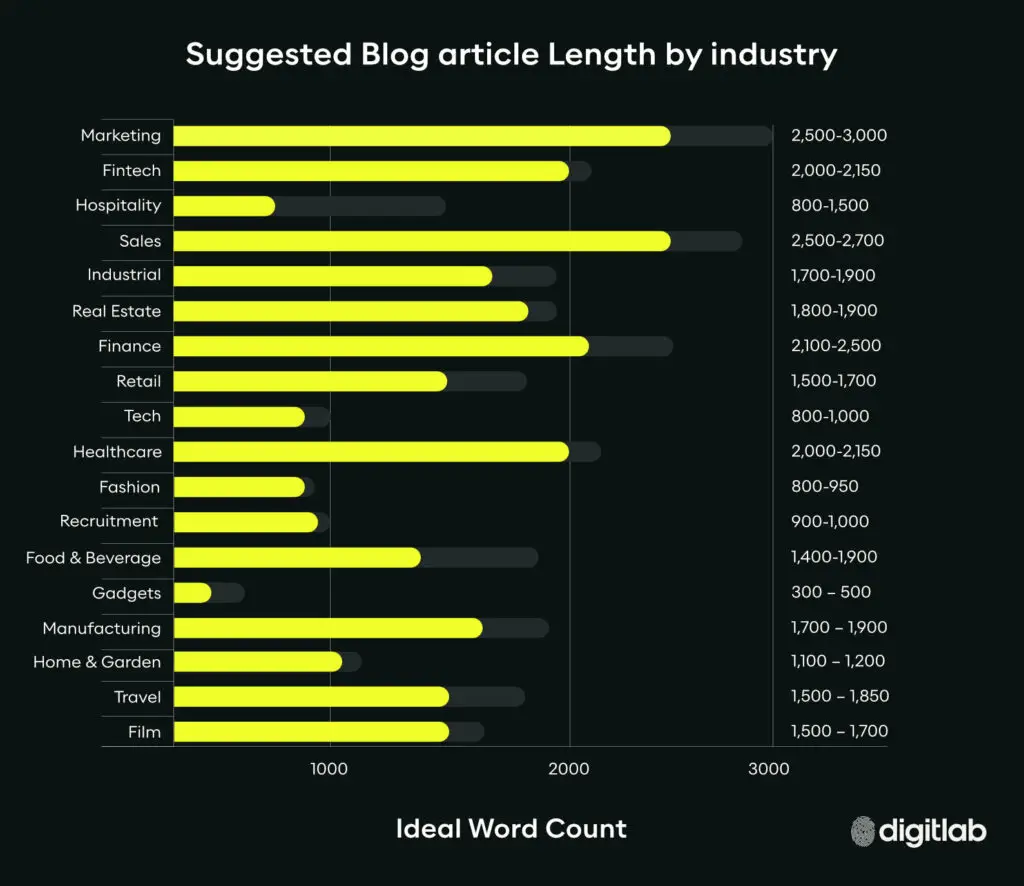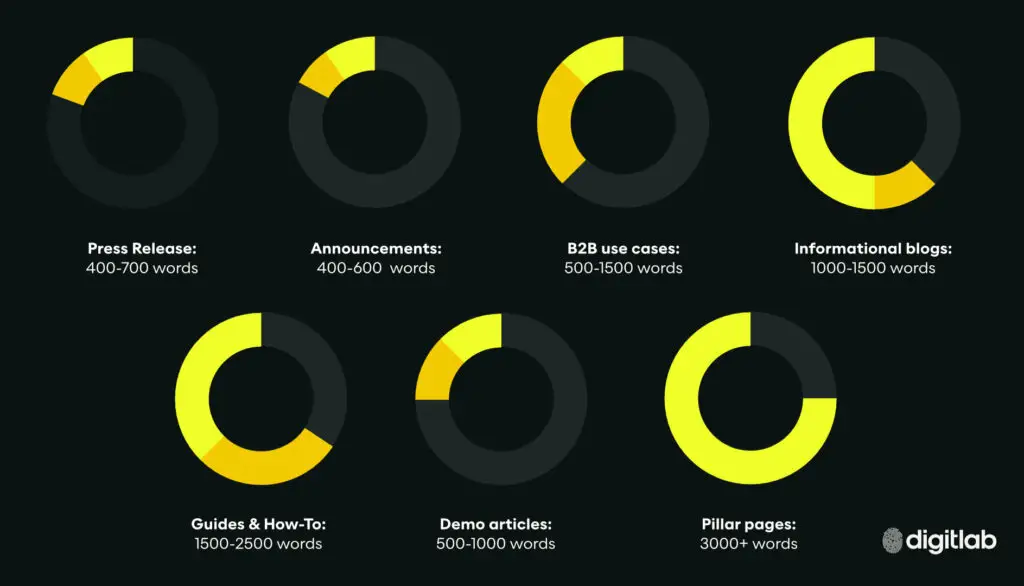In the ever-evolving realm of digital marketing, one common question that plagues marketers and copywriters is, “What is the ideal blog length?”
The answer isn’t as straightforward as one might hope, as it largely depends on several factors, including industry standards, audience preferences, and search engine algorithms.
Let’s delve into the history of the ideal word count, current trends, reasons why long-form content is king, and ideal blog length by industry.
How the ideal word count has evolved

Early Days of Blogging (2000s)
In the early 2000s, when blogging gained popularity, the focus was on brevity and frequency. Bloggers aimed for shorter posts, typically between 300 to 500 words. This was partly due to limited attention spans and a desire to provide quick, easily digestible information to readers.
Emergence of SEO (2000s – 2010s)
As search engine optimisation (SEO) gained traction, content creators began tailoring their articles to meet the algorithms’ requirements. Search engines, particularly Google, started favouring longer-form content, considering it more informative and valuable to users. The recommended word count gradually increased to around 500 to 800 words.
The Rise of Long-Form Content (2010s)
In the mid-2010s, the emphasis shifted towards delivering comprehensive, in-depth content. This marked the era of long-form content, with recommended word counts often exceeding 1,000 words. The rationale behind this was to provide readers with a thorough understanding of the topic and answer their queries comprehensively.
Core Updates and E-A-T (2018 Onwards)
With Google’s implementation of core algorithm updates, the importance of expertise, authoritativeness, and trustworthiness (E-A-T) gained prominence. Longer content was seen as a means to demonstrate expertise and authority on a subject. Blog articles of 1,500 words or more became the new standard. This showcased a deep understanding of topics and boosting SEO rankings.
Current Trends (2020s)
As of the 2020s, the trend of producing longer content persists. Articles exceeding 2,000 words are increasingly common, especially in competitive niches. Content creators and marketers now recognise that longer articles provide a platform for comprehensive coverage, encompassing various aspects of a topic and incorporating relevant keywords for better SEO.
5 reasons long-form content is king
1. Comprehensive Coverage
Long-form content allows for a thorough exploration of a topic. Unlike shorter pieces, which provide a surface-level overview, longer articles dig deep and cover multiple facets of a subject. This comprehensive coverage ensures that readers receive a holistic understanding, making it a valuable resource.
“Comprehensive content ... significantly outperforms content that doesn’t cover a topic in-depth.”
Backlinko & Ahrefs
Not only does this benefit the audience, but it also establishes the credibility and authority of the author or brand. When readers find all the information they need in one place, they are more likely to trust and engage with the content.
2. Improved SEO Performance
Search engine algorithms have evolved to prioritise high-quality, informative content. Long-form content naturally accommodates a broader range of keywords, variations, and semantically related terms. This rich use of keywords helps in improving the article’s visibility in search results.
“The average Google first page result contains 1,447 words.”
Backlinko & Ahrefs
Moreover, longer articles tend to attract more backlinks, a crucial factor in SEO. When other reputable websites link to your content, search engines perceive your page as more authoritative and relevant, ultimately boosting your rankings.
3. Enhanced Authority and Credibility
In-depth, long-form articles position the author or brand as an expert in the field. By thoroughly examining a topic, presenting well-researched data, and providing unique insights, content creators showcase their authority and expertise. This builds credibility and trust among readers, encouraging them to view the author as a reliable source of information.
4. Better Engagement and Time on Page
Engagement metrics are vital indicators of content performance. Long-form content tends to captivate readers for a more extended period, increasing the average time spent on the page. Engaged readers are more likely to read the article in its entirety, interact with calls-to-action, and share the content, amplifying its reach and impact.
“Websites with above-average ‘time on site’ tend to rank higher on Google.”
Backlinko & Ahrefs
5. Opportunity for Internal and External Linking
Long-form articles provide opportunities for both internal and external linking. Authors can insert internal links to other relevant pages, promoting a deeper exploration of their content. Externally, longer articles are more likely to attract backlinks from other websites. This further enhances the article’s authority and contributes to a robust backlink profile.
Ideal blog length by industry
As Neil Patel reveals, the optimal length of a blog article can vary significantly based on the industry it caters to. Each industry has its unique characteristics, target audience, and the level of detail required to effectively engage readers. Here’s Neil’s breakdown of the ideal word count for blog articles in various industries and the reasons behind it:

SEMrush, a global search engine optimisation technology leader, also weighs in on the ideal blog length debate. Instead of breaking it down by industry, SEMrush suggests the ideal blog length based on the type of content:

What the Future Holds
Here’s an in-depth look at five key trends defining copywriting in 2024 and beyond:
Hyper-Personalisation
Personalisation has evolved into a sophisticated practice that goes beyond basic demographics. Content now encompasses finely-tuned individual preferences and behaviours.
According to McKinsey, an overwhelming 71% of consumers expect personalisation, and 76% express frustration when brands fail to meet this expectation.
For content creators, the imperative is evident: delve into first and second-party data to craft content that deeply resonates on a personal level, and ensure linguistic inclusivity through the use of translation services.
Ephemeral Content
Temporary content isn’t merely a novelty; it’s a fundamental aspect of the contemporary digital experience.
Ephemeral content, exemplified by platforms like Instagram Stories or Snapchat, is poised to reshape how audiences are engaged.
Serving as a potent tool, it creates a sense of urgency, fostering more frequent engagement driven by the fear of missing out.
Skillful utilisation of ephemeral content has the power to generate immediate traffic to timely articles and prompt swift actions from the audience.
Collaboration with AI
Artificial intelligence has become an integral component of a copywriter’s workflow.
However, the aim is not to allow AI to overshadow the creative process but to bolster it.
In a market inundated with generic content, distinctiveness emerges as the key differentiator.
Employing AI thoughtfully for research and ideation—rather than content generation—permits the preservation of a unique voice and message in your content.
Long-form Content
The landscape of voice search and SEO algorithm adjustments will have a notable influence on long-form content.
Copywriters must adapt their approach to align with verbal queries, incorporating a conversational tone and long-tail keywords that emulate spoken language to enhance visibility.
The content should strike a balance—being both comprehensive and readable, easily scannable for readers, and voice search-friendly for spoken responses.
Despite the trend towards dynamic content, long-form content remains a stronghold for thought leadership and storytelling, and its evolution only serves to amplify its impact.
Narrative and Storytelling
Copywriting is poised to place increased emphasis on narrative and storytelling as brands strive to forge emotional connections with their audience.
In 2024, a probable trend will involve a fusion of classic storytelling techniques with interactive, cross-platform narratives leveraging the digital realm.
Stories play a pivotal role in bringing content to life and enabling brands to stand out in a saturated digital space.
By seamlessly weaving messages into narratives, brands can craft memorable and engaging experiences for their audience.
The evolution of copywriting is expected to integrate user-generated content and testimonials, contributing to the creation of an authentic, multi-faceted brand narrative.
If you’d like to gain a deeper understanding of how the digital landscape will shift in 2024 and beyond, be sure to download your copy of the Insight 2024: The State of Digital Report today.






